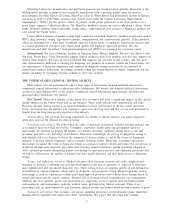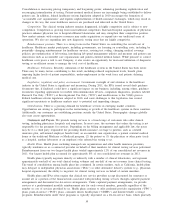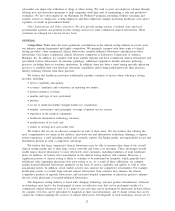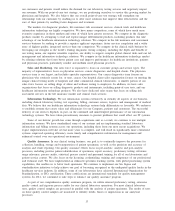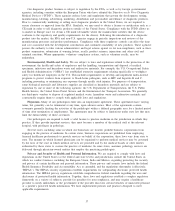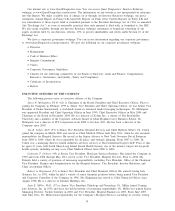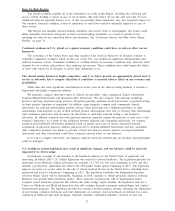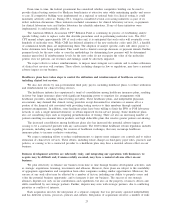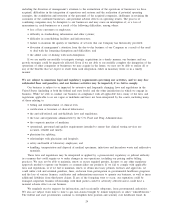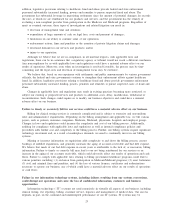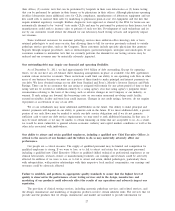Quest Diagnostics 2011 Annual Report Download - page 23
Download and view the complete annual report
Please find page 23 of the 2011 Quest Diagnostics annual report below. You can navigate through the pages in the report by either clicking on the pages listed below, or by using the keyword search tool below to find specific information within the annual report.Our diagnostic product business is subject to regulation by the FDA, as well as by foreign governmental
agencies, including countries within the European Union who have adopted the Directive on In Vitro Diagnostic
Medical Devices (“IVDD”). These agencies enforce laws and regulations that govern the development, testing,
manufacturing, labeling, advertising, marketing, distribution and post-market surveillance of diagnostic products.
Prior to commercially marketing or selling most diagnostic products in the United States, we are required to
secure clearance or approval from the FDA. Similarly, we may need to obtain a license or certification such as a
CE mark in order to sell diagnostic products outside of the United States. Compliance with the IVDD allows us
to market in Europe once we obtain a CE mark (obtainable where the manufacturer certifies that the device
conforms to the regulatory and quality requirements for the device). Following the introduction of a diagnostic
product into the market, the FDA and non-U.S. agencies engage in periodic inspections and reviews of the
manufacturing processes and product performance. Compliance with these regulatory controls can affect the time
and cost associated with the development, introduction and continued availability of new products. These agencies
possess the authority to take various administrative and legal actions against us for non-compliance, such as fines,
product suspensions, submission of warning letters, recalls, product seizures, injunctions and other civil and
criminal sanctions. Where appropriate, voluntary compliance actions, such as voluntary recalls, may be
undertaken.
Environmental, Health and Safety. We are subject to laws and regulations related to the protection of the
environment, the health and safety of employees and the handling, transportation and disposal of medical
specimens, infectious and hazardous waste and radioactive materials. For example, the U.S. Occupational Safety
and Health Administration (“OSHA”) has established extensive requirements relating specifically to workplace
safety for healthcare employers in the U.S. This includes requirements to develop and implement multi-faceted
programs to protect workers from exposure to blood-borne pathogens, such as HIV and hepatitis B and C,
including preventing or minimizing any exposure through needle stick injuries. For purposes of transportation,
some biological materials and laboratory supplies are classified as hazardous materials and are subject to
regulation by one or more of the following agencies: the U.S. Department of Transportation, the U.S. Public
Health Service, the United States Postal Service and the International Air Transport Association. We generally
use third-party vendors to dispose of regulated medical waste, hazardous waste and radioactive materials and
contractually require them to comply with applicable laws and regulations.
Physicians. Many of our pathologists enter into an employment agreement. These agreements have varying
terms, but generally can be terminated at any time, upon advance notice. Most of the agreements contain
covenants generally limiting the activities of the pathologist within a defined geographic area for a limited period
of time after termination of employment. The agreements may be subject to limitations under state law that may
limit the enforceability of these covenants.
Our pathologists are required to hold a valid license to practice medicine in the jurisdiction in which they
practice. If they provide inpatient services, they must become a member of the medical staff at the relevant
hospital, with privileges in pathology.
Several states, including some in which our businesses are located, prohibit business corporations from
engaging in the practice of medicine. In certain states, business corporations are prohibited from employing
licensed healthcare professionals to provide services on behalf of the corporation; these laws vary from state to
state. The manner in which licensed physicians can be organized to perform medical services may be governed
by the laws of the state in which medical services are provided and by the medical boards or other entities
authorized by these states to oversee the practice of medicine. In some states, anatomic pathology services are
delivered through physician-owned entities that employ the practicing pathologists.
Privacy and Security of Health and Personal Information. We are required to comply with laws and
regulations in the United States (at the federal and state levels) and jurisdictions outside the United States in
which we conduct business, including the European Union, India and Mexico, regarding protecting the security
and privacy of certain healthcare and personal information. These privacy and security laws include the federal
Health Insurance Portability and Accountability Act, as amended, and the regulations thereunder (collectively,
“HIPAA”). The HIPAA security regulations establish requirements for safeguarding electronic protected health
information. The HIPAA privacy regulations establish comprehensive federal standards regarding the uses and
disclosures of protected health information. Together, these laws and regulations establish a complex regulatory
framework on a variety of subjects, provide for penalties for non-compliance, and may require a healthcare
provider to notify individuals or the government if the provider discovers certain breaches of unsecured personal
or a patient’s protected health information. We have implemented policies and practices designed to meet
applicable requirements.
17




